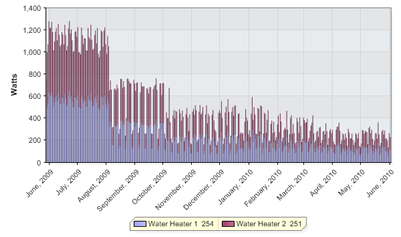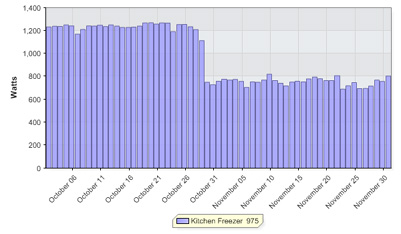-
Case Study #1: The Hot Water Heater

Figure 1: Hot water heater energy consumption.
The Problem
Because EnergyGenius monitors your energy on a circuit by circuit basis, we can see exactly how your energy is wasted. In this instance, the hot water heater is the energy culprit. We determined that a configuration error was causing the recirculation pump to run continuously in this commercial setting. In other words, it never turned off! The only way to discover the problem was by tracking the energy consumption on a circuit by circuit basis.
Data Gets Results
The chart (Figure 1) shows three levels of energy consumption. At the left you'll see the original level before the problem was detected. As a first step, EnergyGenius added a timer to the water heater so that it turned off and on incrementally. This resulted in a drastic reduction of energy which is showed in the middle section of the graph. EnergyGenius then recommended the use of pipe insulation, which reduced the energy consumption even more, which is shown on the right side of the graph.
Cost Effective
Not only was the energy usage cut by 75%, it was inexpensive to implement, costing less than $500 in materials with labor done in house. The yearly savings is projected at $700.
-
Case Study #2: Heating and Air Conditioning Blower
The Problem
The client's bill seemed higher than it should have been on a square foot basis. What we could not see (or hear) was that the blowers on the heating and air conditioning units were running non-stop, wasting a considerable amount of power. Only after tracking energy consumption at their facility on a circuit by circuit basis did we find the problem.
Data Gets Results
After finding the problem we recommended that the client change their thermostat settings to turn off the blowers outside of business hours. This let the blowers run during the day to balance temperature and provide occupant comfort, but allowed them to shut off at night to provide a great deal of energy savings.
Cost Effective
The fix for the project was simple and easy: change the thermostat settings. But savings on a yearly basis was $920. This is the best kind of problem to find: the savings are real and the cost to repair the issue are very small. But without circuit monitoring, it would have been difficult to diagnose.
-
Case Study #3: Soffit Lights
The Problem
The client was looking for a way to conserve energy and money at their facility. They were unaware of where their energy dollars were going. We were able to identify the exterior soffit lighting as a large user of power from dusk to dawn.
Data Gets Results
In order to save power and extend light bulb life, we recommend adding a timer to the photocell control. This allows the lights to turn on at dusk and turn off at midnight. They were able to save power without impacting their sites visibility during the early night time hours.
Cost Effective
The change on this project was adding a timer. Including the expenses from the electrician, the payback on the project was less than six months. Another benefit is savings in bulbs and labor to replace the 20 bulbs around the perimeter of the building.
-
Case Study #4: Is your refrigerator running...All the time?

Figure 2:Freezer energy usage.
The Problem
We noticed in the client's data that their commercial kitchen freezer starting running all the time. Power usage increased to 29 KWH per day which is much higher than before and much higher than what the manufacturer predicts. We alerted our client of the problem and they looked over the unit.
Data Gets Results
The client found that a piece of wax paper had lodged squarely over the air intake for the cooling coil. The airflow was reduced to a trickle.
Cost Effective
The fix was to remove the wax paper. Energy usage dropped immediately to 18 KWH per day. Running with the unit in this impaired condition would have wasted 3950 KWH per year or about $553 per year. It probably also would have shortened the lifetime of the equipment.
-
Case Study #5: Chiller Research
The Problem
A client approached us wanted to quantify a new method for reducing air conditioning costs in a large commercial building. They had a vendor with a new technique for treating cooling tower water without chemicals but the payback was unknown.
Data Gets Results
To help the client find the answer we measured the usage of their two large chiller units and related pumps. The dual chillers were run in alternating weeks with one chiller using the new treatment method and one with the old method.
Cost Effective
The results provided the client with the usage information to compute their payback. The new method was cheaper with some savings coming from energy usage but also savings from avoiding chemical treatment expenses.

